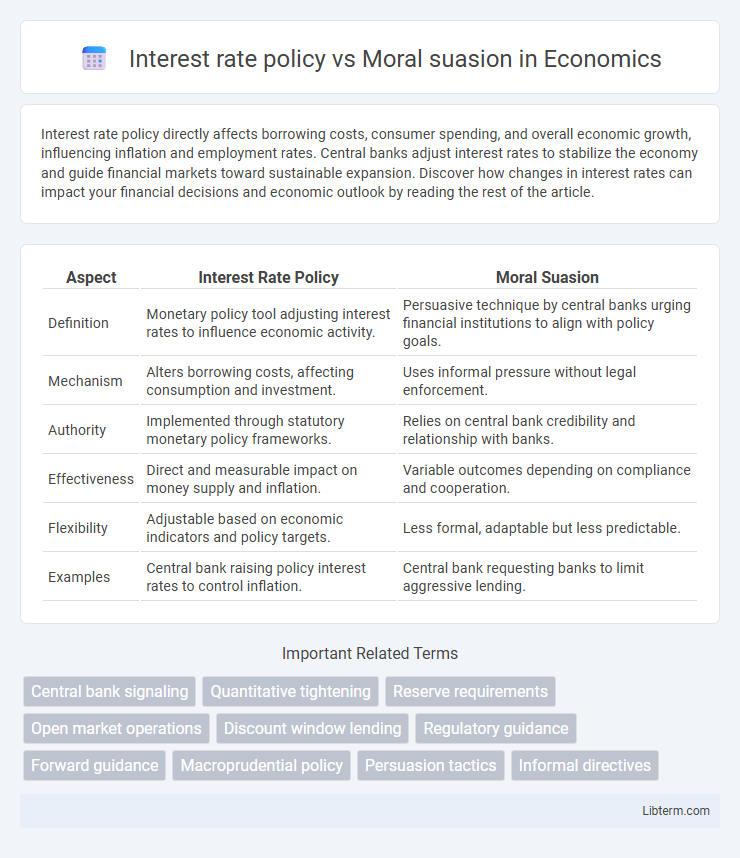Interest rate policy directly affects borrowing costs, consumer spending, and overall economic growth, influencing inflation and employment rates. Central banks adjust interest rates to stabilize the economy and guide financial markets toward sustainable expansion. Discover how changes in interest rates can impact your financial decisions and economic outlook by reading the rest of the article.
Table of Comparison
| Aspect | Interest Rate Policy | Moral Suasion |
|---|---|---|
| Definition | Monetary policy tool adjusting interest rates to influence economic activity. | Persuasive technique by central banks urging financial institutions to align with policy goals. |
| Mechanism | Alters borrowing costs, affecting consumption and investment. | Uses informal pressure without legal enforcement. |
| Authority | Implemented through statutory monetary policy frameworks. | Relies on central bank credibility and relationship with banks. |
| Effectiveness | Direct and measurable impact on money supply and inflation. | Variable outcomes depending on compliance and cooperation. |
| Flexibility | Adjustable based on economic indicators and policy targets. | Less formal, adaptable but less predictable. |
| Examples | Central bank raising policy interest rates to control inflation. | Central bank requesting banks to limit aggressive lending. |
Introduction to Interest Rate Policy and Moral Suasion
Interest rate policy involves central banks adjusting benchmark rates to influence economic activity, control inflation, and stabilize currency value, serving as a primary tool for monetary regulation. Moral suasion refers to the central bank's informal pressure on financial institutions to adhere to desired policies without legal enforcement, relying on persuasion and advisory measures. Both mechanisms play critical roles in shaping financial market behavior and guiding national economic objectives.
Defining Interest Rate Policy
Interest rate policy involves central banks setting benchmark rates to influence economic activity, control inflation, and stabilize the currency. It directly impacts borrowing costs, consumer spending, and investment decisions across the financial system. Unlike moral suasion, which relies on persuasive communication to guide banks' behavior, interest rate policy enforces measurable monetary control through explicit rate adjustments.
Understanding Moral Suasion
Moral suasion is a non-legislative tool used by central banks to influence and persuade financial institutions to adhere to policy guidelines without enforcing mandatory regulations. Unlike interest rate policy, which operates through adjusting benchmark rates to control economic activity, moral suasion relies on appeals to institutional responsibility and cooperation to achieve desired monetary outcomes. This approach often complements formal policies by encouraging banks to lend prudently, maintain liquidity, or stabilize markets through voluntary compliance.
Historical Context of Monetary Policy Tools
Interest rate policy has historically served as a primary monetary tool by influencing borrowing costs and economic activity since the early 20th century. Moral suasion emerged prominently in the mid-1900s as a complementary approach, relying on central bank persuasion to guide financial institutions without formal regulatory power. Both methods reflect evolving strategies in monetary policy frameworks to stabilize economies through direct market intervention and behavioral influence.
Mechanisms of Interest Rate Policy
Interest rate policy functions primarily through adjusting the central bank's benchmark rates to influence borrowing costs, thereby regulating credit supply and demand in the economy. By raising or lowering interest rates, central banks directly affect consumer spending, investment decisions, and inflation levels. In contrast, moral suasion relies on persuasive communication and informal pressure on financial institutions to achieve policy goals without formal rate adjustments.
Techniques Used in Moral Suasion
Moral suasion employs non-coercive techniques such as persuasion, appeals to social responsibility, and informal communication to influence banks and financial institutions to align their behavior with government economic objectives. Techniques include warnings, reminders of ethical obligations, and confidential discussions aimed at encouraging compliance without formal regulatory enforcement. This approach contrasts with interest rate policy, which uses direct financial incentives or penalties to regulate economic activity.
Comparative Effectiveness: Interest Rate Policy vs Moral Suasion
Interest rate policy directly influences borrowing costs and savings behavior, making it a powerful tool for controlling inflation and stimulating economic growth. Moral suasion relies on persuasion and the central bank's credibility to guide financial institutions' behavior without formal enforcement, often leading to less predictable outcomes. Empirical evidence suggests that interest rate adjustments yield more immediate and measurable impacts on economic variables compared to the more subtle and variable effects of moral suasion.
Case Studies: Global Applications and Outcomes
Interest rate policy influences economic activity by adjusting borrowing costs, demonstrated by the Federal Reserve's 2020 rate cuts to stimulate the US economy during the COVID-19 pandemic, which helped stabilize markets but raised concerns about long-term inflation. Moral suasion, employed effectively by the Reserve Bank of India during the 2016 demonetization, leveraged persuasive communication to encourage banks to support government liquidity needs without formal mandates, aiding in financial stabilization. Case studies reveal interest rate policy offers direct market impact with measurable economic outcomes, whereas moral suasion relies on cooperative behavior, often yielding variable results depending on institutional trust and compliance.
Advantages and Limitations of Each Approach
Interest rate policy effectively controls inflation and stimulates economic growth by influencing borrowing costs, but it can lead to market volatility and lagged effects on the economy. Moral suasion leverages regulatory persuasion to encourage banks' compliance with monetary goals without legal enforcement, allowing flexibility, yet it lacks binding power and may result in inconsistent outcomes. Both approaches require careful implementation to balance immediate economic needs and long-term financial stability.
Choosing the Optimal Policy Tool for Modern Economies
Interest rate policy provides a direct mechanism for central banks to influence economic activity by adjusting borrowing costs, which can stabilize inflation and stimulate growth in modern economies. Moral suasion leverages informal pressures and persuasive communication to guide financial institutions' behaviors without formal regulatory changes, often proving effective during periods of uncertainty or crises. Combining interest rate adjustments with strategic moral suasion enables policymakers to tailor interventions, balancing market rigidity and flexibility to optimize economic outcomes.
Interest rate policy Infographic

 libterm.com
libterm.com